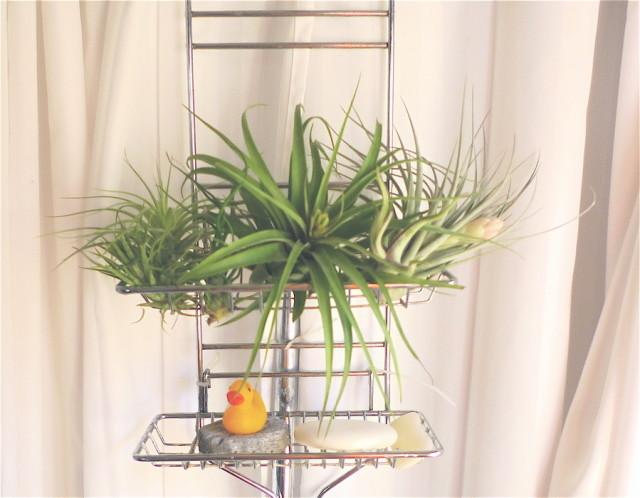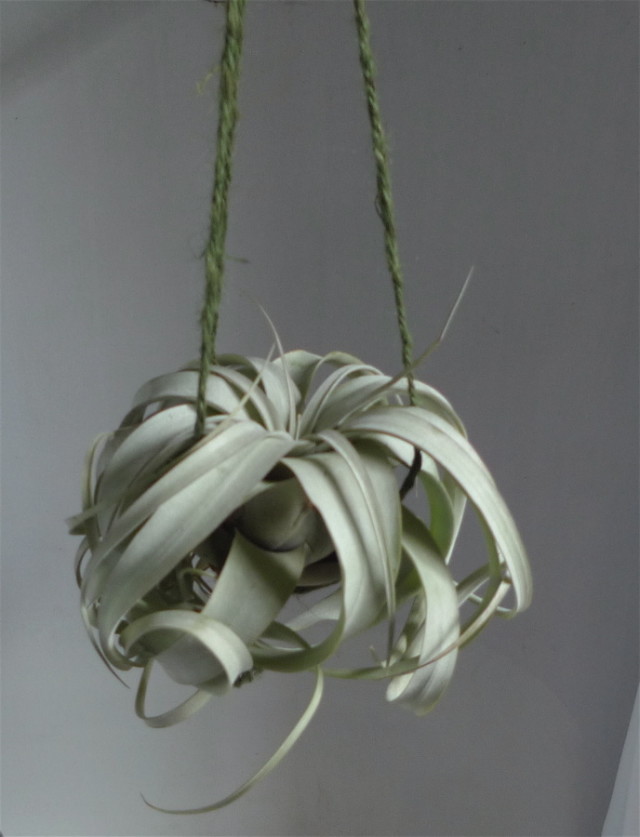Air Plants

Six Tillandsia species I picked up at the Seattle and Portland gardens shows in the past couple of weeks: T. left side: T. medusae, T. ionantha v. mexicana, T. bulbosa; middle: T. streptophylla hybrid; right side: T. stricta, and T. aeranthos x tenuifolia (in case you were wondering). I placed the more silvery-leafed species closer to the window.
Air plants (Tillandsia sp.) make brilliant house plants for non-gardeners. They’re beautiful, don’t require soil or pots, and are easy to care for.
Just pick one of the easier species like Tillandsia argentea or T. ionantha and you need only set the plant in the right spot with bright, filtered light and good air circulation and you’ll get by for years with just a spritz/soak/occasional fertilizing regime.
If you are a gardener — particularly a geography-geek kind of gardener — you’ll be even more entranced, as each species hails from a different region, elevation and environment and has slightly different requirements. Some folks get a kick out of figuring out how to fine-tune care to encourage their Tillandsia to produce flowers or "pups" (baby plants) or even just to grow faster.
One of the best sources for air plants is the local wholesaler Owens Gardens of Monroe, WA. (Phone: 360-794-6422/no website). They sell their plants to a number of Washington State nurseries like Ravenna Gardens and City Peoples. Or, catch the affable husband-and-wife team at a few regional plant sales per year, including at Seattle’s Northwest Flower & Garden Show and Portland’s Yard Garden & Patio Show.
I picked up a whole passel of new varieties in the past few weeks and tucked them into my shower caddy, where they get bright light from a south-facing window, plus humidity and good air circulation.
And since air plants are epiphytes, they don’t need to be "planted." In habitat, they affix themselves by their roots to trees buildings or wires, deriving nutrients and moisture from the air and from run-off rather than their roots. But unless you glue them to a piece of wood, or never ever move them, they probably won’t attach themselves to anything in your home.

Tillandsia xerographica – a gorgeous, silver-leafed air plant from high elevation, dry regions in Salvador, Mexico and Guatemala. It is more drought-tolerant and sun-loving than most air plants and is slow-growing, but can eventually develop into an immense, sculptural rosette over 3’ in diameter. I found this at Owens Gardens at Seattle’s NWFGS.
Tillandsia foliage is diverse – there are over 500 species native to Central and South America, Mexico and the southern United States. Thinner, and more green-leafed varieties, sometimes with almost thread-like foliage, are native to rainier, more humid regions, while thick- and silvery-leafed varieties like Tillandsia xerographica grow in dryer regions, and are often found growing at the tops of trees or clinging to the sunny side of rocks.
Tillandsia foliage ranges from dark olive green, chartreuse, and apple green to cool bluish-green and even silvery-white. Leaves can be long and thin and whisk-like or arranged in curly twists that emerge from charmingly bulbous bases. Some species flower more easily than others but the foliage is so captivating, you won’t mind if they never flower at all.
Tillandsia require only the simplest care regime consisting of weekly spritzing or an hour’s dunk in water, depending on the species and the light and warmth of its location. Just provide a bit more water during the hot summer months and a bit less in winter, when light is lower in our area.
When you buy your air plant, try to get a species name (eg, with Tillandsia bulbosa , " Tillandsia " is the genus and " bulbosa " is the species). That will help you learn how much water and light it prefers. Having said that, it’s hard to go wrong if you place your air plant in bright, filtered light and spritz once or twice weekly and soak every one to three weeks for an hour or so. After soaking, just turn the plant upside down and shake the heck out of it for a few moments before settling it back upright.
For more information about bromeliads in general, including Tillandsia, check out Bromeliad Society International.
